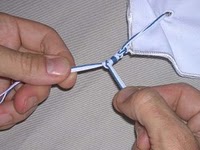Although most people prefer to buy a tallit with the tzitzit already tied, some people prefer tying tzitzit themselves. This inclination should not be seen as a caprice, but as a valid inclination, especially since the Talmud states that performing a mitzvah yourself is better than having someone carry it out for you.
Tying tzitzit is also an important skill to learn, because you will be able to retie tzitzit strings that break or unravel. It’s also a great way to introduce a soon-to-be-bar-mitzvah boy to this important mitzvah.
Tying Tzitzit: Getting started
Obviously, the first thing you’ll need is to buy a set of tzitzit strings. You can find them online (click here) or at your local Judaica store. Ideally you should choose hand-spun tzitzit, because according to some opinions machine-spun tzitzit are not kosher since they lack “lishmah,” or “intention to perform a mitzvah.”
Because tzitzit are invariably made of wool, be sure your tallit is not made of linen to avoid the prohibition of shatnez. (If you don’t have a tallit in mind, click here). Generally the only tallit without tzitzit you will find is a traditional wool tallit.
Now let’s get down to business. Take out the 16 tzitzit strings you’ll find in the package. Lay them out on a table, placing the 4 long tzitzit strings in one row and the 12 shorter strings in another.
Take one long tzitzit string and three shorter strings, stretching them out side by side. Even the ends on one side. You are now ready to insert that side into one of the holes. Before you do, be sure to say the words “lesheim mitzvas tzitzis” (or leshem mitzvat tzitzit, according to the Sephardic pronunciation), meaning literally “for the purpose of the commandment of tzitzit.”
Inserting the strings into the hole can be a bit difficult, but still easier than threading a needle. If you’re having trouble, use a bobby pin. Pull the four ends through until they are approximately even with the three shorter tzitzit ends on the other side. Make a simple knot on the end where all four tzitzit strings are even. This knot is temporary, so make it loose enough that you won’t have trouble untying it later.
Time to tie the knot
Even both ends of the shorter tzitzit strings again. Tie a double knot close to the edge of the cloth near the hole, tight enough so that the knot touches the edge of the fabric. (According to some opinions, the knot should be tight enough that the fabric bunches somewhat.)
Tzitzit tying: The coils

Take the long tzitzit string, which is known as the “shamash.” Wrap it around the other three strings seven times and tie a double knot.
Now again wrap the shamash around the other tzitzit strings eight times and make a double knot.
Wrap the shamash around 11 times and tie a double knot.
Finally, wrap the shamash around 13 times and make a double knot.
Untie the temporary knot and – voila! – your first corner is ready. Once you have finished tying tzitzit on the remaining three corners, your tallit will be ready to wear.
Cutting tzitzit strings
When you finish tying the tzitzit, you may find that the strings are uneven, and usually the shamash will be longer than the other strings. If you like, you can cut the strings, but ideally you should avoid using a metal blade (just as the Torah proscribes cutting the stones for the Holy Temple with metal implements). One option is to cut the tzitzit using your front teeth, though it is very hard to get a clean cut. (Notice that you have 32 teeth, just as there are 32 tzitzits strings hanging from your tallit.) Another option is to use a shard of glass. (This has a side advantage: next time a child breaks a glass, you’ll find it easier to keep your cool.) Tzitzit professionals generally use zirconium oxide scissors.
If they fray slightly, you can dip the ends of the tzitzit strings in wax or nail polish to prevent further fraying.
The first few times you wear it, the final double knot is liable to come a bit unraveled, but if you keep checking your tzitzit knots and tightening them, you won’t have to retie them at all. Be aware that tying a double knot on Shabbat is strictly forbidden, which can be frustrating if you’re sitting in shul and notice you’re starting to come unraveled.
I’m currently experimenting with a technique I invented to keep the knots tight. I simply hold the final knot under hot water for five or ten seconds and hang it to dry. As far as I can tell there’s no damage to the tzitzit strings. I’ve found this is especially helpful for boys, because their knots come loose quickly with new tzitzit and they don’t bother to tighten them. By the time I notice, a few knots have already started to unravel.
Tying tzitzit with techelet
If you have techelet tzitzit, tying the tzitzit is a much more complicated affair and is beyond the scope of this article. For video presentations of nine (!) different ways to tie techelet tzitzit, go to the Ptil Tekhelet tying guide.
Techelet tzitzit and regular all-white tzitzit are available for purchase on this site, on the Tzitzit strings page.
More tzitzit articles:
Tzitzit Buyers Guide
How Tzitzit are Made
Tying Tzitzit Before Bar Mitzvah
Tsitsit: Tucked in or Showing?
Pele Yoetz on the Meaning of Tzitzit

